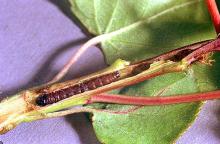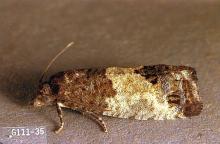Spilonota ocellana
Pest description and crop damage Adults are greyish moths about 0.5 inch long with a thick white band across each forewing. Mature larvae are chocolate-brown with black heads, and less than 0.5 inch in length. The eyespotted bud moth is principally a pest in Oregon.
Biology and life history Larvae spend the winter in a cocoon on the bark in the crotches of small-diameter limbs. They become active around budbreak and feed on leaves and buds, webbing together leaves and flower petals, then feeding within these tissues. Mature larvae pupate within the webbed tissues and adult moths emerge in early to mid-summer. Eggs are laid on the lower surface of leaves. The larvae emerge and feed on the lower leaf surface until early August, at which time they construct their overwintering cocoons (hibernacula).
Pest monitoring In the spring, look for larvae in nests of webbed-together leaves and flower petals.
Management-chemical control: HOME USE
- carbaryl-Highly toxic to bees.
Management-chemical control: COMMERCIAL USE
Growing-season spray
- carbaryl (Carbaryl 4L) at 2 to 3 quarts/A. REI 12 hr. PHI 3 days. Extremely toxic to aquatic invertebrates; avoid spray drift and runoff to surface waters.
- spinosad (Entrust SC) at 4 to 8 fl oz/A. REI 4 hr. PHI 1 day. Results are best when applied at petal fall. May act slowly. OMRI-listed for organic use.



